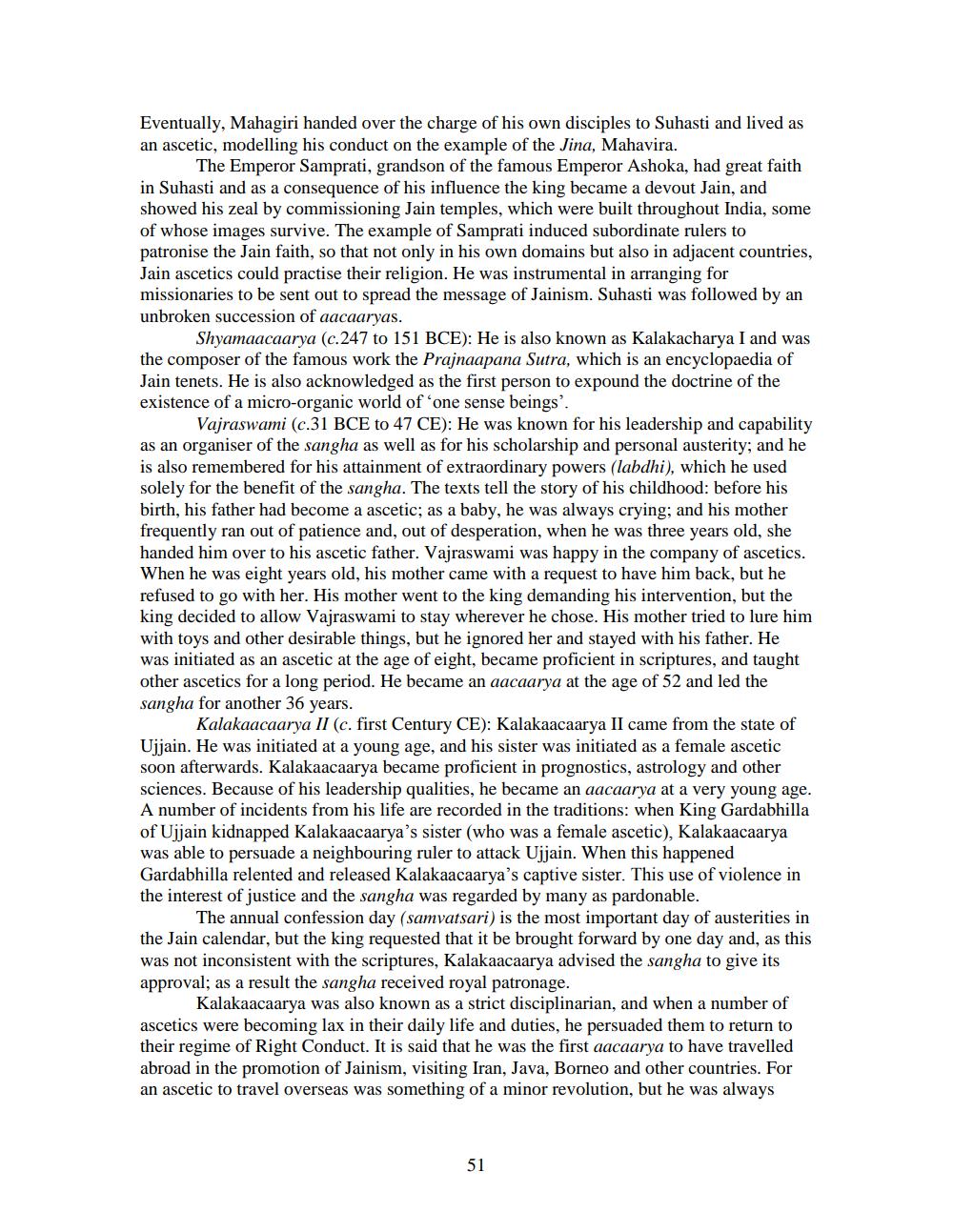________________
Eventually, Mahagiri handed over the charge of his own disciples to Suhasti and lived as an ascetic, modelling his conduct on the example of the Jina, Mahavira.
The Emperor Samprati, grandson of the famous Emperor Ashoka, had great faith in Suhasti and as a consequence of his influence the king became a devout Jain, and showed his zeal by commissioning Jain temples, which were built throughout India, some of whose images survive. The example of Samprati induced subordinate rulers to patronise the Jain faith, so that not only in his own domains but also in adjacent countries, Jain ascetics could practise their religion. He was instrumental in arranging for missionaries to be sent out to spread the message of Jainism. Suhasti was followed by an unbroken succession of aacaaryas.
Shyamaacaarya (c.247 to 151 BCE): He is also known as Kalakacharya I and was the composer of the famous work the Prajnaapana Sutra, which is an encyclopaedia of Jain tenets. He is also acknowledged as the first person to expound the doctrine of the existence of a micro-organic world of 'one sense beings'.
Vajraswami (c.31 BCE to 47 CE): He was known for his leadership and capability as an organiser of the sangha as well as for his scholarship and personal austerity; and he is also remembered for his attainment of extraordinary powers (labdhi), which he used solely for the benefit of the sangha. The texts tell the story of his childhood: before his birth, his father had become a ascetic; as a baby, he was always crying; and his mother frequently ran out of patience and, out of desperation, when he was three years old, she handed him over to his ascetic father. Vajraswami was happy in the company of ascetics. When he was eight years old, his mother came with a request to have him back, but he refused to go with her. His mother went to the king demanding his intervention, but the king decided to allow Vajraswami to stay wherever he chose. His mother tried to lure him with toys and other desirable things, but he ignored her and stayed with his father. He was initiated as an ascetic at the age of eight, became proficient in scriptures, and taught other ascetics for a long period. He became an aacaarya at the age of 52 and led the sangha for another 36 years.
Kalakaacaarya II (c. first Century CE): Kalakaacaarya II came from the state of Ujjain. He was initiated at a young age, and his sister was initiated as a female ascetic soon afterwards. Kalakaacaarya became proficient in prognostics, astrology and other sciences. Because of his leadership qualities, he became an aacaarya at a very young age. A number of incidents from his life are recorded in the traditions: when King Gardabhilla of Ujjain kidnapped Kalakaacaarya's sister (who was a female ascetic), Kalakaacaarya was able to persuade a neighbouring ruler to attack Ujjain. When this happened Gardabhilla relented and released Kalakaacaarya's captive sister. This use of violence in the interest of justice and the sangha was regarded by many as pardonable.
The annual confession day (samvatsari) is the most important day of austerities in the Jain calendar, but the king requested that it be brought forward by one day and, as this was not inconsistent with the scriptures, Kalakaacaarya advised the sangha to give its approval; as a result the sangha received royal patronage.
Kalakaacaarya was also known as a strict disciplinarian, and when a number of ascetics were becoming lax in their daily life and duties, he persuaded them to return to their regime of Right Conduct. It is said that he was the first aacaarya to have travelled abroad in the promotion of Jainism, visiting Iran, Java, Borneo and other countries. For an ascetic to travel overseas was something of a minor revolution, but he was always




